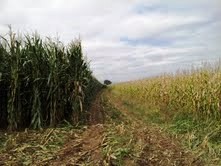
July 2015—Alhough farmers everywhere win and lose according to the whims of unpredictable weather and climate trends, Macedonia’s farmers are further burdened by a number of other challenges that have a domino effect on the industry. One recent development, however, is interrupting the negative chain reaction.
Across the country, farmers continue to rely on inefficient trench irrigation to water their corn crops, which in turn feed Macedonia’s dairy cows. The labor-intensive, time-consuming irrigation method washes away fertilizers and produces anemic yields. The national average corn yield of 4.3 metric tons per hectare is well below the western European average of 10.3 metric tons. This limited supply of feed can sustain only a limited number of dairy cows, who then produce a limited supply of milk.
Because the high cost of imported feed exceeds what can be recouped in milk revenue, herd size is limited by the amount of feed farmers can grow themselves. As a result, the local milk supply doesn’t meet the demand of Macedonia’s struggling dairy processors. Many import as much as a fifth of their raw milk supply and still operate below their processing capacities.
But despite the dreary backdrop, Dragi Nechevski, a farmer in the southern Macedonian village of Lera, is beaming with optimism. He is one of 40 dairy farmers who participated in the pilot year of a USAID economic growth initiative that gets at the front of this supply chain shortage with a simple yet highly effective solution—drip irrigation.
In 2013, as part of the Grow More Corn initiative of USAID's Small Business Expansion Project, the farmers agreed to have USAID install drip irrigation on 1 hectare of their land to demonstrate both the ease and impact of this method to other farmers.
Nechevski’s drip-irrigated hectare produced nearly twice as much corn as his best hectare without the system, and the dramatic results were clearly visible.
“My neighbors would slow their tractors and crane their necks when they drove past,” Nechevski. “It was really something to see!”
Last year, Nechevski installed drip-irrigation systems on 4 more hectares and expanded his herd from 30 to 40 cows. He’s pacing himself, but intends to steadily grow his herd by keeping the female calves each year.
To date, USAID has installed 280 hectares of drip irrigation in Macedonia, each hectare demonstrating ease of use and impressive results to neighboring farmers.
Although helping individual farmers get a better return on their labor is a nice byproduct, the project’s goal is to effect a sea change in agricultural practices related to livestock feed and dairy production while having a broader impact on Macedonia's economy as a whole.
As word spreads, the number of farmers using drip irrigation, and the number of hectares of corn being grown with it, are poised to grow exponentially. Milk production is on the rise and the impact is being felt throughout the dairy industry.
In addition to low yields and inefficient cultivation methods, other challenges confronting Macedonia’s farmers include loosely written contracts between producers, processors and distributors that offer only limited assurances. Revenue insecurity, combined with unusually high collateral requirements from lenders, make it difficult for farmers to invest in upgrades or expand their operations.
The Small Business Expansion Project, which runs from April 2012 to September 2016, is also helping banks to better understand the financial needs of famers, assess the value of agricultural enterprises, and recognize alternative collateral assets. Impressed by the results of the Grow More Corn initiative, Macedonia's Ministry of Agriculture, in consultation with project staff, is helping farmers purchase drip-irrigation equipment through a national cost-share subsidy program.
LINKS
Follow @USAIDMacedonia, on Facebook, on YouTube







Comment
Make a general inquiry or suggest an improvement.